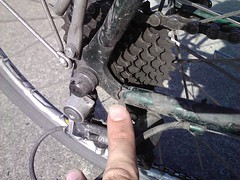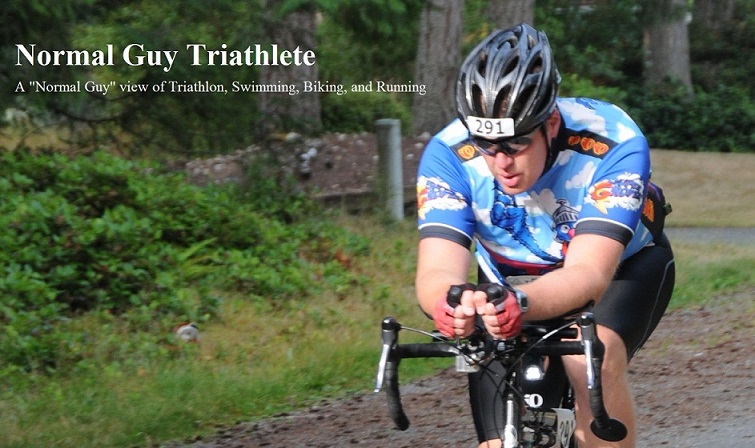
Cracked rear dropout on the chainstay, driveside.
Since this can be considered a gear review, please note my standard review disclaimer.
This post was STARTED back in October but, well, life happens. I actually made the purchase last July. Now you can enjoy it after 3 months of editing!
Back in July my trusty all-weather commuter bike bit the dust. It was sad to lose an old friend but there is an upside...
I get to go bike shopping!
My primary training method for triathlon season is bike commuting so replacing my main commuter bike was a top priority before the weather turned sour.
At the outset I must let it be known that I am a geek: technically minded, detail oriented, and obsessive about certain things that most people would consider trivial. As such this entire process may seem remarkably similar to a technical RFP (Request For Proposals)
Why not just troll Craigslist for a cheap beater bike? I tried that for a few weeks and couldn't find a bike that fit my requirements that was in my size. There are lots of bikes on Criagslist but once you get into the larger/sturdier bikes... you would have better luck finding a date for Saturday night that wouldn't land you in jail.
In 2007 I went bike shopping for the first time in nearly 15 years. I was floored by the shear number of choices to be made. I like having lots of alternatives but the number of decision points can be staggering-
- Bike type: standard diamond frame, recumbent, or trike?
- Riding surface: road, off-road, or hybrid?
- Frame material: steel, aluminum, carbon, titanium, wood, bamboo...? (the list goes on)
- Big name brand, low-cost leader, or custom built?
I'll just stop right there. That only covers the basics of getting started. From there you have to think about brakes, drive train, handlebars, and a hundred other factors that go into making "the perfect bike."
HINT: This is no such thing as the perfect bike. Trying to find the perfect bike will drive you nuts.
Shopping Methodology
These are the basic steps I used to decide on my latest purchase-
- Gather requirements
- Look around at what is currently on the market
- Make an exhaustive list of possible choices
- Narrow down the list through online research, visiting local bike shops, and in online forums
- Test-ride the top 3
- Final decision and purchase
Step #1: Gather requirements
Buying my first real bike in 2007 was what my wife called my "rookie mistake." Over the next several years I took notes about what I liked/disliked about my bike and looked for other models that would have better suited my needs. I ended up with a pretty good list of priorities to use in my bike evaluation process.
Main purpose: serve as an all-weather commuter (95%) and a touring bike for on and off-road (5%).
Requirements-
- NOT carbon fiber: steel or aluminum preferred
- Disc brakes
- Lower gears via a compact triple or large granny-gear on the rear cassette
- Drop bars
- Mounts for fenders and rear rack
- Purchase from a local bike shop (LBS)
- Heavy-duty (rims, frame, forks)
"Nice to have" items-
- Mounts for a front rack
- 150+ mm saddle (I'm a big guy)
My first requirements were fit, durability, and a LBS but eventually I added disc brakes to the list after seeing how many were available in the 2011-12 models. In the colder/wetter months the route I like to use has a very steep hill (NE 42nd way, 16-20% grade) and going down that hill with wet rim brakes is almost a religious experience.
Step #2: Check out what's on the market
This has been going on since 2007. Yes, I have been looking around and taking notes on bikes since I bought my last one almost 5 years ago.
Step #3: The exhaustive list
My short list turned out not to be so short-
Specialized Tricross Elite Disc
Steps #4 and 5: Narrowing down the list and test riding
After some extensive online research the was whittled down to the Kona Honky (Eastside Ski & Sport), Salsa Vaya (Kirkland Bike), and the Specialized Tricross (Pacific Bicycle). Now the real fun begins: shopping the local stores and test riding!
Kona Honky Inc.
My first stop was Eastside Ski & Sport to check out the Kona Honky Inc. Don't let the name get to you: this bike is all business. Although it does sound like you are about to blow your nose.
Pros:
- Steel frame
- Disc brakes (Avid BB-7)
- Drop Bars
- More "upright" geometry than your run-of-the-mill road bike
- Mounts for front/rear racks and fenders
Cons:
- Short cage derailleur, 12-28 cassette (not the best climbing gear)
- No clearance for tires wider than 28mm.
- Didn't like the fit on the larger sizes
Summary: It fell short in only a couple of places. Very nice bike with a quality build. Handling was great with fantastic response.
Salva Vaya
Next stop: Kirkland Bike to check out the Salsa Vaya. This bike caught my interest last year when I discovered they had a titanium version. If my budget was a little bigger I would have jumped on the Ti version: it is one sweet looking ride.
Pros:
- Steel frame
- Disc brakes (Avid BB-5)
- Drop Bars
- VERY "upright" geometry, more so than the Kona Honky Inc.
- Mounts for front/rear racks and fenders
Cons:
- 48/36 Front chainring (compared to 50/34 on other models)
- Didn't like the fit
Summary: It was hard to say no to this bike. The fit just wasn't right. I had my eye on it for almost 18 months and was ready to buy it until I saw...
Specialized TriCross Elite Disc
I dropped into Gerks Ski and Cycle in Redmond, WA, on a whim one day after work. After only a few minutes I found the Specialied TriCross Elite Disc sitting in the very back of the store without a price tag. Turns out it belonged to the sales guy. They didn't have a floor model because it was a 2012 model and they weren't yet shipping in quantity. Gerks didn't even have literature on it. The bike was gorgeous! The look of the brushed aluminum was amazing. I was SOLD. The sales guy said he would call around to see where I could find one. I gave him my number and went home. He never called back.
The next day I went down to Pacific Bicycle, just over a mile from my house in Sammamish, WA. The sales guy was much younger than the other stores but he knew his stuff (turns out he was the son of the owner). They didn't have the new TriCross Disc model but they did have a TriCross Comp, which has the same geometry, and in the right size (61cm frame size, measured from the height of the seat tube).
Pros:
- Aluminum frame
- Disc brakes (Avid BB-5)
- Drop Bars
- Cyclocross geometry, not as upright as the Honky Inc. or Vaya but still quite comfortable
- Mounts for front/rear racks and fenders
- 155mm saddle
- Secondary brake levers (along the top, flat-part of the drop bar)
Cons:
- Aluminum gets a little wobbly when I really load up the rack.
- Rear disc is outside the rear triangle, just above the rear dropout, which means I needed a rear rack that attaches via an extra-long skewer.
Summary: The aluminum frame isn't as stiff as steel but it still beats my carbon bike in terms of handling. Everything else about the bike is what I was looking for: durability, disc brakes, and the right gearing (climbing gears but high gears as well).
Step #6: Final decision
I was sold on the TriCross Disc before I even officially rode it. I took the Tricross Comp for a test ride and ordered the disc model on the spot.
The first thing I did after getting it home was replace the incredibly cheap plastic platform pedals with my Shimano A530s(SPD/platform combo).
The disc brakes stop very quickly. When I first got on the bike I was just about to ask them to tighten the brakes and then, mid-sentence, I almost flipped over the bars in the parking lot when I braked too hard.
So far I am very satisfied with my choice. I should cross the 1000 miles barrier by the end of the month (2 weeks away!). No issues so far other than normal maintenance and cleaning. I did have to learn the care and feeding of disc brakes. That little red wheel has to be turned slightly every few weeks to keep the brakes adjusted properly.
Here it is fresh home from the shop with rack and fenders (still has the stock pedals)-
A couple of honorable mentions:
Salsa Fargo: Imagine a 29er mountain bike with drop bars and you have the Fargo. Not quite what I'm looking for in terms of riding style but this one certainly is bullet-proof. The website even uses the term "bikepacking". They even have a titanium version.
Salsa Casseroll: This one bike of note that was eliminated early due to lack of disc brakes. It reminds me a LOT of the old ‘70s Schwinn that my Dad handed down to me in the late 80’s. If I wasn’t so set on disc brakes I may have purchased this instead. Very sweet looking ride.
Kona Sutra: One of the best loaded-touring bikes. Not really the ride I want. It's like driving a truck. I was looking for more of a SUV-hybrid.
Specialized Source 11: Very similar to the TriCross but with a Shimano SuperNova generator hub, integrated lights with routed cables, rack/fenders, a front light, and a belt drive with interally-geared hub. I knocked if of the list due to the price ($2700) and the flat bar otherwise this is my perfect commuter.
Trek Soho: Like the Specialized Source but with a belt drive and internally-geared rear hub.
Update: I was just pointed to the Civia Bryant. WOW. Another worthy choice but it missed my radar before I made my purchase. Internally geared rear hub, belt drive, drop bars, disc brakes, steel frame... WOW.




